These charts suggest a US recession could be closer than we think
Neither investors nor economists are worried about the US. But there’s plenty of evidence to suggest a recession could be just around the corner, says Dominic Frisby.


Every year, Ronald-PeterStoeferle and MarkJValek of investment and asset management company Incrementum put together the report In Gold We Trust 160-plus pages of charts and thoughts, mostly gold-related, on the state of the world's finances.
There's so much to look at and consider. It's a sort of digital equivalent of a coffee-table book.
Yesterday I got an email from them, containing a "best of" a compendium of some of the best charts from this year's report.
MoneyWeek
Subscribe to MoneyWeek today and get your first six magazine issues absolutely FREE

Sign up to Money Morning
Don't miss the latest investment and personal finances news, market analysis, plus money-saving tips with our free twice-daily newsletter
Don't miss the latest investment and personal finances news, market analysis, plus money-saving tips with our free twice-daily newsletter
I thought in today's Money Morning, we might flick through some of them...
Commodities are very cheap compared to stocks
Suddenly the last five years don't feel quite as bad. In the mid-$1,200s is sort of normal (since 2008, at least).
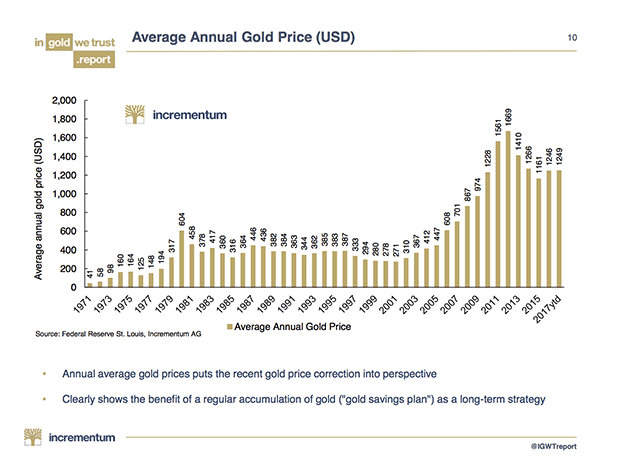
This next chart got me very excited. It shows the ratio of the Goldman Sachs commodities index to the S&P 500 the ratio of commodities to stocks, in other words.
Commodities are as cheap on a relative basis as they were in the late 1990s and at the beginning of the 1970s. In other words, very cheap indeed.
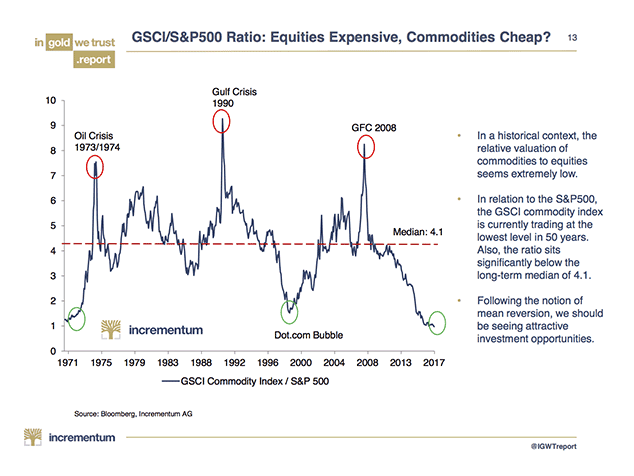
I'm quite bullish on industrial metals and energy at present. I think such "late cycle" assets will do well in a stock bull market which is mature and, probably, a lot closer to the end than the beginning of its cycle. I don't, however, think that commodities are the irresistible bargain they were in 1999.
The chart above, however, would suggest otherwise. It is screaming, "buy commodities, sell stocks". The inference is that there is some inflation around the corner.
Could a US recession be around the corner?
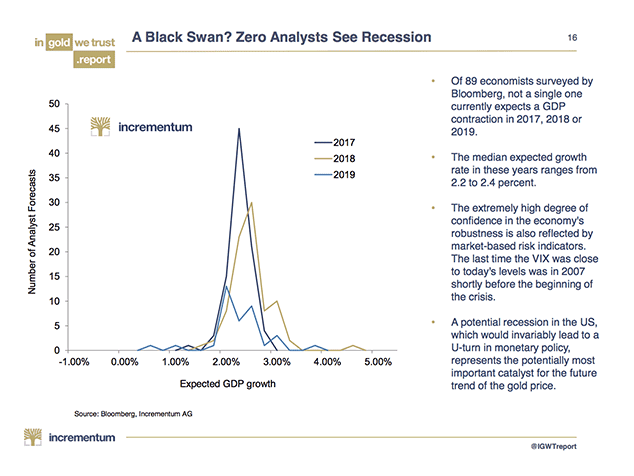
Are we now in a rate-hiking cycle? In the US we seem to be, even if interest rates now stand at only 1.25%. The Bank of England meets next week. Inflation, as judged by the Consumer Price Index (CPI) the Bank's target measure came in at 3% yesterday, the last report before the Bank's meeting. Surely even Mark Carney has to put up rates now.
That could be a significant turning point. According to this next chart, 16 of the last 19 rate rise cycles have led to recessions.
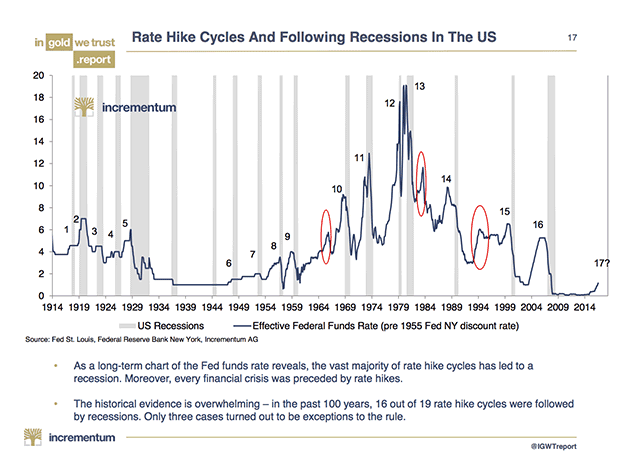
That doesn't necessarily mean that interest-rate rises cause recessions often it's the over-expansion caused by the loose monetary policies which preceded the rate rises but nevertheless there does seem to be some kind of relationship. Perhaps more rate rises could result in the recession that nobody is forecasting.
Following on from that, the next chart hints that all is not as well with the economy as we might believe. As someone who did a show at the Edinburgh Festival on tax and is now writing a book on the same subject, any cool tax charts are bound to get the blood flowing, and this is no exception.
The S&P 500 may be rising but gross tax revenues aren't. The amount of tax being paid, whether on a personal or corporate level, is indicative of how much people are earning and how much economic activity is taking place. Tax receipts are in decline. The omens are not good.
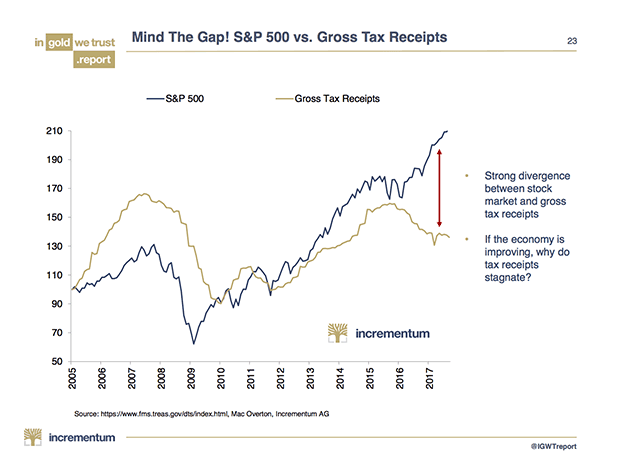
You could draw the same chart for net corporate tax receipts. The pattern is the same.
It's another hint that the economy is not faring quite as well as the stockmarket suggests it is.
What if gold were money again?
The first shows, basically, the ratio of the money supply ie, the amount of money that has been printed compared to savings. The higher the blue bar, the less money is being saved.
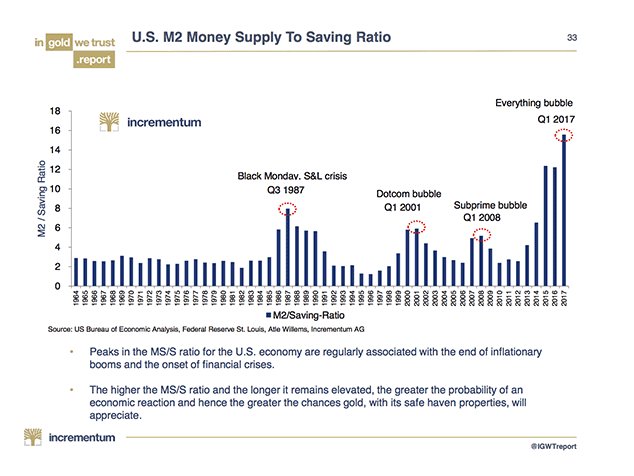
If the narrative of this chart is believed, this is not going to end well although I stress that you could have made the same point in 2014, 2015 and 2016 , so perhaps we will be making the same observation for another three years.
Lastly, some simultaneously sensible yet ridiculous projections of the gold price in the future.
During the 1980 Iranian hostage crisis, gold went to $850 an ounce for a day. On that day 21 January the US dollar was, effectively, fully backed by gold. At $850 an ounce, the market value of the 260 million ounces of gold owned by the US and mostly stored in Fort Knox (don't mention the audit) reached $221bn. Yet only some $160bn paper dollars were in issue.
So US gold was actually worth 140% of US paper. So low was confidence in the dollar (indeed all paper money at the time), that the US had, in a way, been put back onto a gold standard. One Zurich banker declared: "The US Treasury is once again solvent, thanks to the high price of gold".
Many gold bugs including yours truly at one stage were waiting for that day to come again. Because money supply and debt are so high, central banks will lose control, confidence will be lost and gold will soar as a result.
I now see such a scenario as most unlikely though I stress it has happened many times before, so there's no reason it can't happen again. And in such a light, we consider the table below.
There are all sorts of different measures of money supply.
M0 and M1 are basically cash and other money equivalents that are easily convertible into cash. M2 is M1 plus short-term time deposits in banks and money market funds. M3 is M2 plus longer-term time deposits and money market funds. The exact definitions vary from country to country.
The following table shows what price gold would be if it were equivalent to 20%, 40% or 100% of the various measures of US money.
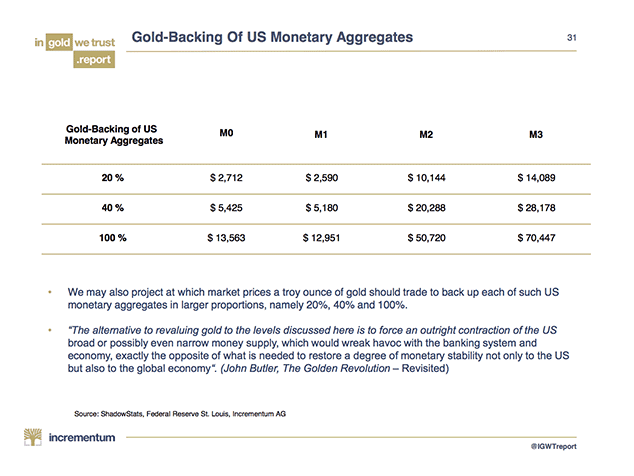
In the event of some kind of fiat crisis akin to that of 1980, the numbers start getting pretty big. 140% of M1 the intraday 1980 number would give us a gold price somewhere near $18,000. Nice work if you can get it. Although I imagine bitcoin will get to $18,000 long before gold does.
But this all makes the assumption that, at some stage, prevailing attitudes to gold that it is an analogue relic in a digital world will change. And that it will be ascribed some kind of value as money in extremis. I'm not so sure that day will ever happen, or at least not in the near term. Others will disagree.
In any case, the main takeaways from the charts are then that both gold and commodities are cheap, relative to both money supply and to stockmarkets; and that, based on tax receipts, contrarian forecasting and rate cycles, some kind of contraction is more likely than many think.
Food for thought, I think you'll agree.
Get the latest financial news, insights and expert analysis from our award-winning MoneyWeek team, to help you understand what really matters when it comes to your finances.
Dominic Frisby (“mercurially witty” – the Spectator) is as far as we know the world’s only financial writer and comedian. He is the author of the popular newsletter the Flying Frisby and is MoneyWeek’s main commentator on gold, commodities, currencies and cryptocurrencies. He has also taken several of his shows to the Edinburgh Festival Fringe.
His books are Daylight Robbery - How Tax Changed our Past and Will Shape our Future; Bitcoin: the Future of Money? and Life After the State - Why We Don't Need Government.
Dominic was educated at St Paul's School, Manchester University and the Webber-Douglas Academy Of Dramatic Art.
You can follow him on X @dominicfrisby
-
 My 6.5% Nationwide regular saver is due to mature - what are my options?
My 6.5% Nationwide regular saver is due to mature - what are my options?Nationwide’s 6.5% regular saver is due to mature for those who opened one last year. Here is what you can do now to make the most of your savings
-
 Leading European companies offer long-term growth
Leading European companies offer long-term growthOpinion Alexander Darwall, lead portfolio manager, European Opportunities Trust, picks three European companies where he'd put his money
